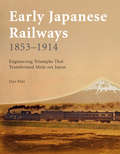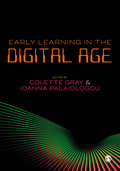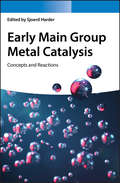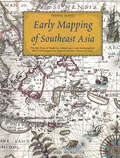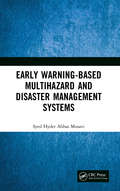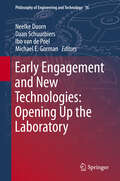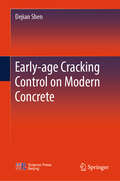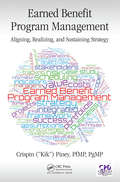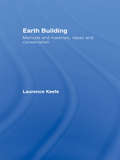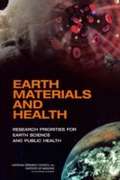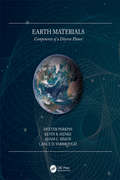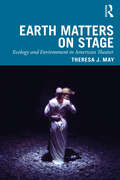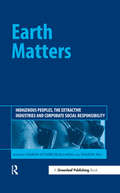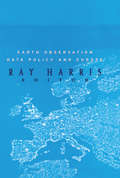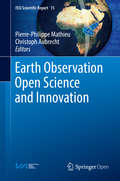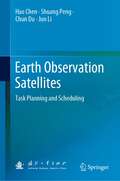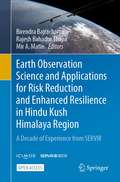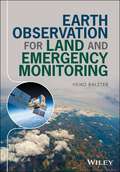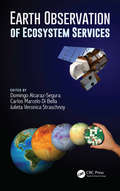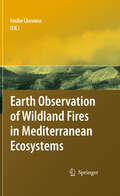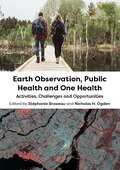- Table View
- List View
Early Japanese Railways 1853 - 1914
by Dan FreeEarly Japanese Railways 1853-1914 is a cultural and engineering history of railway building in Japan during the Meiji era. The 19th century was the first age of sustained, comprehensive contact between Asia and the West. This book describes the history of Japanese social adaptation to railway development, with many details never-before-published in English. In addition, Early Japanese Railways 1853-1914 details the often overlooked American efforts to build the first railways in Japan. This richly illustrated account also takes a look at long disused corporate logos, locomotive data and headlamp marker codes. Many of the photos and illustrations, all pulled from the author's private collection, are quite rare and are not widely known, even in Japan.Appealing to more than just railroad fans, this fascinating account of early Japanese efforts to build railways also paints a clear picture of the Meiji era and the historical, cultural and social ramifications of the railway in Japan.
Early Japanese Railways 1853 - 1914
by Dan FreeEarly Japanese Railways 1853-1914 is a cultural and engineering history of railway building in Japan during the Meiji era. The 19th century was the first age of sustained, comprehensive contact between Asia and the West. This book describes the history of Japanese social adaptation to railway development, with many details never-before-published in English. In addition, Early Japanese Railways 1853-1914 details the often overlooked American efforts to build the first railways in Japan. This richly illustrated account also takes a look at long disused corporate logos, locomotive data and headlamp marker codes. Many of the photos and illustrations, all pulled from the author's private collection, are quite rare and are not widely known, even in Japan.Appealing to more than just railroad fans, this fascinating account of early Japanese efforts to build railways also paints a clear picture of the Meiji era and the historical, cultural and social ramifications of the railway in Japan.
Early Learning in the Digital Age: Digital Pedagogy And Early Childhood
by Ioanna Palaiologou Colette GrayDigital practices are forging ahead in leaps and bounds. Examining digital practices in early childhood education, this book seeks to inform the discussion on how digital technologies are best integrated into play-based pedagogy, and demonstrates effective practices that enhance children’s learning and development. With a range of international contributors, perspectives, and case studies, the fusion of play and portable technology is explored through contemporary research.
Early Learning in the Digital Age: Digital Pedagogy And Early Childhood
by Ioanna Palaiologou Colette GrayDigital practices are forging ahead in leaps and bounds. Examining digital practices in early childhood education, this book seeks to inform the discussion on how digital technologies are best integrated into play-based pedagogy, and demonstrates effective practices that enhance children’s learning and development. With a range of international contributors, perspectives, and case studies, the fusion of play and portable technology is explored through contemporary research.
Early Main Group Metal Catalysis: Concepts and Reactions
by Sjoerd HarderEarly Main Group Metal Catalysis gives a comprehensive overview of catalytic reactions in the presence of group 1 and group 2 metals. Chapters are ordered to reaction type, contain educational elements and deal with concepts illustrated by examples that cover the main developments. After a short introduction on polar organometallic chemistry and synthesis of early main group metal complexes, a variety of catalytic reactions are described, e.g. polymerization of alkenes, hydroamination and phosphination reactions, hydrosilylation, hydroboration and hydrogenation catalysis, as well as enantioselective and Lewis-acid catalysis. The book addresses organic chemists and researchers in industry interested in the state-of-the-art and new possibilities of early main group metal catalysis as well as newcomers to the field. Written by a team of leaders in the field, it is a very welcome addition to the area of main group metal chemistry, and to the field of catalysis.
Early Mapping of Southeast Asia
by Thomas SuarezEarly Mapping of Southeast Asia follows the story of mapmaking, exploration and colonization in Asia from the 16th to the 19th centuries. It surveys Southeast Asia's geography and civilizations, its maps and their influence on Western worldviews, as well as the image of Southeast Asia in the eyes of its neighbors.
Early Warning-Based Multihazard and Disaster Management Systems
by Syed Hyder MusaviThis book describes in detail disaster management principles with applications through software and early warning systems. The aim is to introduce the concept of advanced technology for disaster management. Hence, it starts with a basic introduction and the types of disasters this technology will address. It then examines these functions by taking into account various factors vulnerable to disaster losses. Finally, the results are discussed with the aid of software: OPNET and SAHANA Disaster Management Tool. The application of sensor systems to manage a disaster is also extensively discussed. Features Introduces the concept of disaster management from the perspective of application of advanced technologies for disaster management Provides an overview of applied electronics for disaster applications Examines the role of efficient and robust Information and Communication Technology (ICT) systems for reduction of response time and for augmenting meaningful usage of resources during the disaster management phases of relief, response, recovery and rehabilitation
Early engagement and new technologies: Opening up the laboratory
by Ibo van de Poel Neelke Doorn Daan Schuurbiers Michael E. GormanDespite the topic's urgency and centrality, this is the first edited volume to offer a comprehensive assessment of the varying approaches to early engagement with new technologies, including nanotechnology, synthetic biology, biotechnology and ICT. Covering five main approaches to early engagement--constructive technology assessment (CTA), value-sensitive design (VSD), midstream modulation (MM), the network approach for moral evaluation, and political technology assessment--the book will be a pivotal text in the rapidly developing research field of ELSI, which explores the ethical, legal, and social implications of new technologies. Featuring leading scholars who discuss each early engagement approach in turn, the chapters cover both theory and applications, and include evaluative assessments of specific instances of early adoption of technologies. Further contributions focus on theoretical issues relevant to all approaches, including interdisciplinary cooperation, normativity and intervention, and political and public relevance. The publication has added profile due to the requirement of multi-billion-dollar research programs in the US and Europe to engage in ELSI research alongside that of the technical development itself, even in the early stages. Its comprehensive scrutiny of the core factors in early engagement will ensure a readership of policy makers as well as scientists and engineers.
Early-age Cracking Control on Modern Concrete
by Dejian ShenThis monograph is written based on the author's extensive research over the last decade on the assessment and control of cracking of early-age concrete. The technique of crack control of modern concrete at early age is further developed through experimental and theoretical research, such as mitigating the drop of IRH, controlling the hydration process, decreasing the shrinkage, and increasing the tensile strength. It indicates the innovative findings and establishes prediction models on early-age internal relative humidity, autogenous shrinkage, tensile creep of modern concrete considering water-to-cement ratio, curing temperature., etc; reveals the variation law and mechanism of early-age cracking resistance of modern concrete with different kinds of fibers, supplementary cementitious materials, chemical admixtures, and internal curing agents under circumferential or uniaxial restrained condition. It is designed as a reference work for professionals or practitioners and a textbookfor undergraduates or postgraduates.
Earned Benefit Program Management: Aligning, Realizing, and Sustaining Strategy (Best Practices in Portfolio, Program, and Project Management)
by Crispin PineyNo one can disagree that benefits are good things. Whether you are responsible for projects, programs, or portfolios, you are increasingly expected to think—and act—in an appropriate benefits-driven way. However: Do you understand that what may be appropriate for a project may be inapplicable for a program? Can you avoid the trap of wishful thinking based on overinflated expectations and underestimated costs? Can you manage your program or portfolio from inception to final delivery in a consistent, benefits-focused way based on a single, coherent model? This book describes how Earned Benefit Program Management techniques provide an innovative, all-inclusive model and set of tools developed specifically to answer these questions. This model consolidates the key concepts of project, program, and portfolio management and ensures that all program and portfolio management steps are carried out based on a single, signed-off model in a consistent, verifiable manner within a consolidated life cycle. This approach guarantees alignment with strategic goals and constraints through every stage of a program. Case studies highlight the key features of the approach and provide important lessons and insights for managing programs. Although the ideas and concepts for each topic are fully consistent with existing standards and other published material, they are based on new thinking and go beyond current practice. They provide a set of original and powerful techniques that are applicable to both programs and portfolios in a wide range of business environments.
Earth Building: Methods and Materials, Repair and Conservation
by Laurence KeefeBuildings with load-bearing earth walls were once widespread throughout Britain and many thousands still survive, including some dating from the fourteenth and fifteenth centuries. Earth is the ultimate form of ‘green’ building construction, creating no environmental pollutions and consuming virtually no energy. Subsoil can be dug from or near the site to construct buildings that will meet modern needs and conform to the latest building regulations. This book describes all aspects of earth building, explaining how earth performs as a building material and providing guidance on how best to repair and conserve existing earth buildings.
Earth Materials And Health: Research Priorities For Earth Science And Public Health
by National Research Council Institute of Medicine of the National AcademiesA range of natural earth materials, like arsenic or fluoride, have long been linked to significant human health effects. Improved understanding of the pervasive and complex interactions between earth materials and human health will require creative collaborations between earth scientists and public health professionals. At the request of the National Science Foundation, U.S. Geological Survey, and National Aeronautics and Space Administration, this National Research Council book assesses the current state of knowledge at the interface between the earth sciences and public health disciplines. The book identifies high-priority areas for collaborative research, including understanding the transport and bioavailability of potentially hazardous earth materials, using risk-based scenarios to mitigate the public health effects of natural hazards under current and future climate regimes, and understanding the health risks that result from disturbance of earth systems. Geospatial information - geological maps for earth scientists and epidemiological data for public health professionals - is identified as one of the essential integrative tools that is fundamental to the activities of both communities. The book also calls for increased data sharing between agencies to promote interdisciplinary research without compromising privacy.
Earth Materials: Components of a Diverse Planet
by Adam C. Simon Dexter Perkins Kevin R. Henke Lance D. YarbroughThere is a large and growing need for a textbook that can form the basis for integrated classes that look at minerals, rocks, and other Earth materials. Despite the need, no high-quality book is available for such a course. Earth Materials is a wide-ranging undergraduate textbook that covers all the most important kinds of (inorganic) Earth materials. Besides traditional chapters on minerals and rocks, this book features chapters on sediments and stratigraphy, weathering and soils, water and the hydrosphere, and mineral and energy deposits. Introductions to soil mechanics and rock mechanics are also included.This book steers away from the model of traditional encyclopedic science textbooks, but rather exposes students to the key and most exciting ideas and information, with an emphasis on thinking about Earth as a system. The book is written in such a manner as to support inquiry, discovery and other forms of active learning. All chapters start with a short topical story or vignette, and the plentiful photographs and other graphics are integrated completely with the text.Earth Materials will be interesting and useful for a wide range of learners, including geoscience students, students taking mineralogy and petrology courses, engineers, and anyone interested in learning more about the Earth as a system.
Earth Matters on Stage: Ecology and Environment in American Theater (Routledge Studies in Theatre, Ecology, and Performance)
by Theresa J. MayEarth Matters on Stage: Ecology and Environment in American Theater tells the story of how American theater has shaped popular understandings of the environment throughout the twentieth century as it argues for theater’s potential power in the age of climate change. Using cultural and environmental history, seven chapters interrogate key moments in American theater and American environmentalism over the course of the twentieth century in the United States. It focuses, in particular, on how drama has represented environmental injustice and how inequality has become part of the American environmental landscape. As the first book-length ecocritical study of American theater, Earth Matters examines both familiar dramas and lesser-known grassroots plays in an effort to show that theater can be a powerful force for social change from frontier drama of the late nineteenth century to the eco-theater movement. This book argues that theater has always and already been part of the history of environmental ideas and action in the United States. Earth Matters also maps the rise of an ecocritical thought and eco-theater practice – what the author calls ecodramaturgy – showing how theater has informed environmental perceptions and policies. Through key plays and productions, it identifies strategies for artists who want their work to contribute to cultural transformation in the face of climate change.
Earth Matters: Indigenous Peoples, the Extractive Industries and Corporate Social Responsibility
by Ciaran O'Faircheallaigh Saleem AliIndigenous peoples have historically gained little from large-scale resource development on their traditional lands, and have suffered from its negative impacts on their cultures, economies and societies. During recent decades indigenous groups and their allies have fought hard to change this situation: in some cases by opposing development entirely; in many others by seeking a fundamental change in the distribution of benefits and costs from resource exploitation. In doing so they have utilised a range of approaches, including efforts to win greater recognition of indigenous rights in international fora; pressure for passage of national and state or provincial legislation recognising indigenous land rights and protecting indigenous culture; litigation in national and international courts; and direct political action aimed at governments and developers, often in alliance with non-governmental organisations (NGOs). At the same time, and partly in response to these initiatives, many of the corporations that undertake large-scale resource exploitation have sought to address concerns regarding the impact of their activities on indigenous peoples by adopting what are generally referred to as "corporate social responsibility" (CSR) policies. This book focuses on such corporate initiatives. It does not treat them in isolation, recognising that their adoption and impact is contextual, and is related both to the wider social and political framework in which they occur and to the activities and initiatives of indigenous peoples. It does not treat them uncritically, recognising that they may in some cases consist of little more than exercises in public relations. However, neither does it approach them cynically, recognising the possibility that, even if CSR policies and activities reflect hard-headed business decisions, and indeed perhaps particularly if they do so, they can generate significant benefits for indigenous peoples if appropriate accountability mechanisms are in place. In undertaking an in-depth analysis of CSR and indigenous peoples in the extractive industries, the book seeks to answer the following questions. What is the nature and extent of CSR initiatives in the extractive industries and how should they be understood? What motivates companies to pursue CSR policies and activities? How do specific political, social and legal contexts shape corporate behaviour? What is the relationship between indigenous political action and CSR? How and to what extent can corporations be held accountable for their policies and actions? Can CSR help bring about a fundamental change in the distribution of benefits and costs from large-scale resource exploitation and, if so, under what conditions can this occur? Earth Matters gathers key experts from around the world who discuss corporate initiatives in Alaska, Ecuador, Australia, Canada, Peru, Papua New Guinea, Indonesia and Russia. The book explores the great diversity that characterises initiatives and policies under the name of "corporate social responsibility", the highly contingent and contextual nature of corporate responses to indigenous demands, and the complex and evolving nature of indigenous–corporate relations. It also reveals much about the conditions under which CSR can contribute to a redistribution of benefits and costs from large-scale resource development. Earth Matters will be essential reading for those working in and studying the extractive industry worldwide, as well as those readers looking for a state-of-the-art description of how CSR is functioning in perhaps its most difficult setting.
Earth Observation Data Policy and Europe
by Ray HarrisEarth observation data policy has received little attention, even though the conditions of access to Earth observation data are fundamental to the exploitation of and the further growth of the Earth observation sector. This unique book addresses this limitation.
Earth Observation Open Science and Innovation (ISSI Scientific Report Series #15)
by Pierre-Philippe Mathieu Christoph AubrechtThis book is published open access under a CC BY 4. 0 license. Over the past decades, rapid developments in digital and sensing technologies, such as the Cloud, Web and Internet of Things, have dramatically changed the way we live and work. The digital transformation is revolutionizing our ability to monitor our planet and transforming the way we access, process and exploit Earth Observation data from satellites. This book reviews these megatrends and their implications for the Earth Observation community as well as the wider data economy. It provides insight into new paradigms of Open Science and Innovation applied to space data, which are characterized by openness, access to large volume of complex data, wide availability of new community tools, new techniques for big data analytics such as Artificial Intelligence, unprecedented level of computing power, and new types of collaboration among researchers, innovators, entrepreneurs and citizen scientists. In addition, this book aims to provide readers with some reflections on the future of Earth Observation, highlighting through a series of use cases not just the new opportunities created by the New Space revolution, but also the new challenges that must be addressed in order to make the most of the large volume of complex and diverse data delivered by the new generation of satellites.
Earth Observation Satellites: Task Planning and Scheduling
by Jun Li Hao Chen Shuang Peng Chun DuThis book highlights the practical models and algorithms of earth observation satellite (EOS) task scheduling. EOS task scheduling is a typical complex combinatorial optimization problem with NP-Hard computational complexity. It is a key technology in aerospace scheduling and has attracted global attention. Based on the actual needs of the EOS operation control center, the book summarizes and reviews the state of the art in this research and engineering field. In both deterministic scenarios and dynamic scenarios, the book elaborates on the typical models, algorithms, and systems in centralized, distributed, and onboard autonomous task scheduling. The book also makes an outlook on the promising technologies for EOS task planning and scheduling in the future. It is a valuable reference for professionals, researchers, and students in satellite-related technology. This book is a translation of an original Chinese edition. The translation was done with the help of artificial intelligence. A subsequent human revision was done primarily in terms of content, so that the book will read stylistically differently from a conventional translation.
Earth Observation Science and Applications for Risk Reduction and Enhanced Resilience in Hindu Kush Himalaya Region: A Decade of Experience from SERVIR
by Rajesh Bahadur Thapa Birendra Bajracharya Mir A. MatinThis open access book is a consolidation of lessons learnt and experiences gathered from our efforts to utilise Earth observation (EO) science and applications to address environmental challenges in the Hindu Kush Himalayan region. It includes a complete package of knowledge on service life cycles including multi-disciplinary topics and practically tested applications for the HKH. It comprises 19 chapters drawing from a decade’s worth of experience gleaned over the course of our implementation of SERVIR-HKH – a joint initiative of NASA, USAID, and ICIMOD – to build capacity on using EO and geospatial technology for effective decision making in the region. The book highlights SERVIR’s approaches to the design and delivery of information services – in agriculture and food security; land cover and land use change, and ecosystems; water resources and hydro-climatic disasters; and weather and climate services. It also touches upon multidisciplinary topics such as service planning; gender integration; user engagement; capacity building; communication; and monitoring, evaluation, and learning. We hope that this book will be a good reference document for professionals and practitioners working in remote sensing, geographic information systems, regional and spatial sciences, climate change, ecosystems, and environmental analysis. Furthermore, we are hopeful that policymakers, academics, and other informed audiences working in sustainable development and evaluation – beyond the wider SERVIR network and well as within it – will greatly benefit from what we share here on our applications, case studies, and documentation across cross-cutting topics.
Earth Observation for Land and Emergency Monitoring
by Heiko BalzterEarth Observation Science (EOS) is the study of the global Earth land-ocean-atmosphere system through observations. The principal tools for such studies are measurements from space since these provide the coverage of the planet that is necessary to capture the behaviour of the entire coupled system. In addition, surface observations, and measurements from aircraft, balloons and sounding rockets provide valuable contributors to what are now termed "integrated, global observing systems.” Coupled with models, the EOS measurement suites provide powerful tools for research into the factors controlling and changing the Earth system in which we live. The objectives of this book are to describe new methods and applications of satellite technology in the fields of land and emergency monitoring. It draws on new research outcomes from the European FP7 project GIONET (European Centre of Excellence in Earth Observation Research Training). GIONET combines industrial partners with universities and research institutes, and this book provides a perspective on Earth Observation applications that is motivated by the cross-fertilisation of both sectors. Hence, this book will find readers in both industry and academia. This book highlights a broad range of innovative uses of Earth Observation technology to support environmental management, decision making, crisis management and climate policies. It uses advanced concepts of multi-sensor image integration, multi-temporal analysis and synergies between data and models. This is a truly interdisciplinary subject that encompasses a range of applications in various fields which are discussed in detail throughout the text. If you are interested in remote sensing applications and looking for inspiration, this is the book for you.
Earth Observation of Ecosystem Services (Earth Observation of Global Changes)
by Domingo Alcaraz-Segura Carlos Marcelo Di Bella Julieta Veronica StraschnoyA balanced review of differing approaches based on remote sensing tools and methods to assess and monitor biodiversity, carbon and water cycles, and the energy balance of terrestrial ecosystem. Earth Observation of Ecosystem Services highlights the advantages Earth observation technologies offer for quantifying and monitoring multiple ecosystem fun
Earth Observation of Global Changes (EOGC)
by Jukka M. Krisp Liqiu Meng Roland Pail Uwe StillaThis book provides a collection of selected articles that have been submitted to the Earth Observation and Global Changes (EOGC2011) Conference. All articles have been carefully reviewed by an international board of top-level experts. The book covers a wide variety of topics including Physical Geodesy, Photogrammetry & Remote Sensing, High-Resolution and Fast-Revisiting Remote Sensing Satellite Systems, Global Change & Change Detection, Spatial Modelling, GIS & Geovisualization. The articles document concrete results of current studies related to Earth Sciences. The book is intended for researchers and experts working in the area of Spatial Data Analysis, Environmental Monitoring/Analysis, Global Change Monitoring and related fields.
Earth Observation of Wildland Fires in Mediterranean Ecosystems
by Emilio ChuviecoWildland fires are becoming one of the most critical environmental factors affecting a wide range of ecosystems worldwide. In Mediterranean ecosystems (including also South-Africa, California, parts of Chile and Australia), wildland fires are recurrent phenomena every summer, following the seasonal drought. As a result of changes in traditional land use practices, and the impact of recent climate warming, fires have more negative impacts in the last years, threatening lives, socio-economic and ecological values. The book describes the ecological context of fires in the Mediterranean ecosystems, and provides methods to observe fire danger conditions and fire impacts using Earth Observation and Geographic Information System technologies.
Earth Observation, Public Health and One Health: Activities, Challenges and Opportunities
by Brazeau Stéphanie Nicholas H. OgdenThis book reviews the contributions of Earth Observation (EO) to public health practices. It examines how EO is being used to understand, track, predict, and manage infectious and chronic diseases, and it provides discussion on the current challenges and the significant development potential of EO to a One Health approach. Its objective is to address a set of questions: How does EO currently assist public health activities? What are the challenges for operational use of EO in public health? What are the opportunities for EO to benefit public health in the near future? This review concentrates on the following priority themes to which EO and geomatics can make important contributions: mosquito-borne and tick-borne diseases; water-borne diseases; air quality and extreme heat effects; and geospatial indicators of vulnerable human populations. EO has also demonstrated potential during the COVID-19 pandemic as an efficient provider of data on rapid environmental and socio-economic changes and impacts. Remotely sensed data are particularly useful for risk modelling and mapping projects to help generate information on occurrence and spatio-temporal trends of disease risk. Similarly, EO can be used to identify risk factors for disease risk or emergence detected in surveillance, and support development of early warning systems. Risk maps enable public health professionals to anticipate and prepare for health threats, and they can support responses to infectious disease epidemics or existing endemic conditions. This book emerged from the collaboration of the Public Health Agency of Canada and the Canadian Space Agency with contributions of international experts. Their findings will be of great value to public health and EO professionals interested in developing and applying geospatial applications in the risk assessment and management of public health issues.
Earth Observations and Geospatial Science in Service of Sustainable Development Goals: 12th International Conference of the African Association of Remote Sensing and the Environment (Southern Space Studies)
by Souleye WadeThis book provides a unique insight into the research and recent developments undertaken among the African Remote Sensing community in regard to the environment. It includes reports of the latest research outcomes in the field of remote sensing and geospatial information technologies, analyses discussions around operational topics such as capacity building, Spatial Data Infrastructure (SDI), applications of advanced remote sensing technologies (LiDAR , Hyperspectral) in Africa, big data, space policy, and topics of high actually in the field of climate changes, ocean and coastal zone management, early warning systems, natural resources management or geospatial science for sustainable development goals. The book comprises the contributions of the AARSE (African Association of Remote Sensing of the Environment) international conference which is conducted biennially across Africa, alternately with the AfricaGIS conference. It is the premier forum in Africa for research on remote sensing technologies and geospatial information science, gathering leading scholars from the remote sensing and related communities. The conference is co-organised by the Arab Academy of Science and Technology, in partnership with the National Authority for Remote Sensing & Space Sciences (NARSS) of Egypte, and continues a long series of successful AARSE conferences which started in 1996, in Harare (Zimbabwe) and has been held in Abidjan (Cote D'Ivoire) in 1998, Cape Town (South Africa) in 2000, Abuja (Nigeria) in 2002, Nairobi (Kenya) in 2004, Cairo (Egypt) in 2006, Accra (Ghana) in 2008, Addis Abeba (Ethiopia) in 2010, El Jadida (Morocco) in 2012, Johannesburg (South Africa) in 2014, and in Kampala (Ouganda) in 2016. The book is mainly addressed to practitioners and experts from academia, politics and industry.
